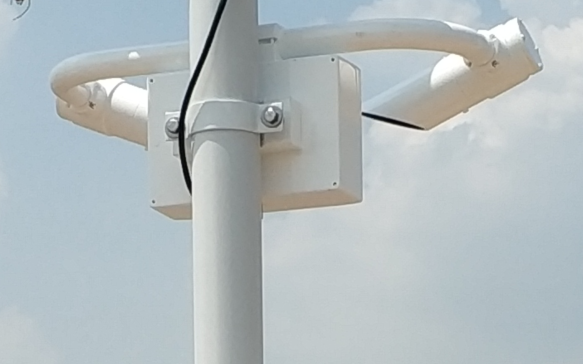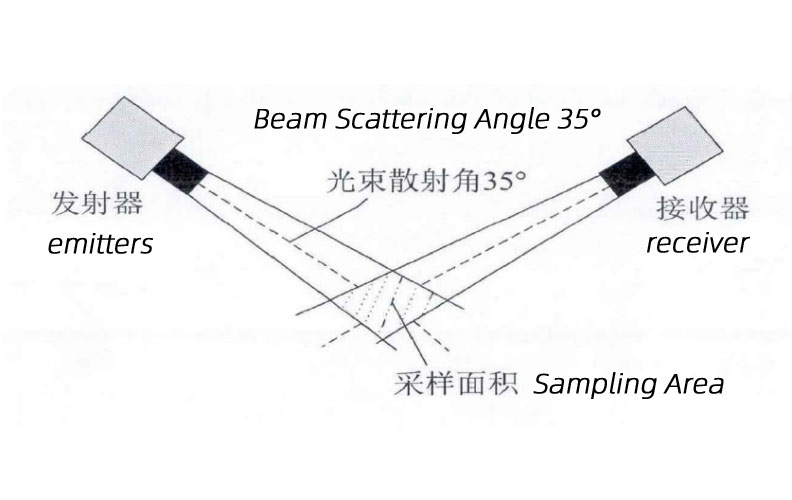

— Blogs —
—Products—
 Consumer hotline +8618073152920
Consumer hotline +8618073152920 WhatsApp:+8615367865107
Address:Room 102, District D, Houhu Industrial Park, Yuelu District, Changsha City, Hunan Province, China
Product knowledge
Time:2024-07-09 15:36:32 Popularity:1055
Visibility sensors are typically instruments that measure the visibility conditions in the immediate vicinity of the current location. A visibility meter consists of main components such as a light emitter, a light receiver, and a microprocessor controller. The emitter sends out infrared pulse light, while the receiver detects the forward scatter of pulse light intensity by aerosol particles in the atmosphere. All measurement information is collected by the microprocessor controller and converted into meteorological optical range (MOR) through specific mathematical models and algorithms to measure various parameters in the atmosphere, such as fog, smoke, sand dust, and other suspended particles, thus inferring visibility conditions.
Regarding the interpretation of 5-10km visibility sensor, we can explain it from the following aspects:
1. About of 5-10km Visibility Sensor
A "5-10km visibility sensor" refers to the maximum horizontal visibility distance that the sensor can measure, reaching 5-10 kilometers. Visibility refers to the maximum horizontal distance that an object can be seen by the naked eye, which is affected by suspended particles in the atmosphere such as dust, smoke, and fog droplets. Therefore, such sensors are of great importance in fields such as meteorological observation, traffic management, and aviation navigation, as they can help people understand the visibility conditions at the current location and make corresponding decisions in time.
2. Test Data Value: Current Position or Other Position
Visibility sensors mainly test the visibility conditions around the installation position. They measure and calculate the intensity and angle of scattered light in the atmosphere to estimate the maximum visible distance under the current atmospheric conditions.

The range of 5-10KM of a visibility sensor's measurement refers to the maximum horizontal visibility distance that the sensor can measure, which is up to 10 kilometers from its current position. However, it is important to note that this does not mean the sensor can "directly see" or "test" the visibility at a specific point 10 kilometers away. The sensor measures and calculates the properties of scattered light in the atmosphere to estimate the average or representative visibility value across the entire measurement range. This value is based on the sensor's location and the surrounding atmospheric conditions, not an accurate measurement of a specific distant point.
Additionally, actual measurements may be affected by various factors such as atmospheric stability, sensor accuracy, and environmental factors (such as terrain and building obstructions), which may influence the accuracy of measurement results.
Therefore, although the measurement range of visibility sensors is 5-10km, we should understand that this data is an estimate of a relative range, not an accurate measurement of visibility at a specific point 10 kilometers away.
3. How to Determine Conditions 10 km Away
However, for the question of "how to determine conditions 10 km away," it is important to note that visibility sensors themselves cannot directly judge the conditions 10 km away.
Nevertheless, in practical applications, we can indirectly infer the visibility conditions 10 km away through the following methods:
1. Refer to historical data: If the area has long-term meteorological observation data, analyzing historical visibility data can help estimate the current visibility trends or changes over a period of time.
2. Observe weather phenomena: Observing the intensity and range of current weather phenomena (such as fog, haze, rain, snow, etc.) combined with meteorological forecasts can provide an initial judgment on whether visibility 10 km away will be affected.
3. Use higher-level measurement equipment: As mentioned earlier, more advanced measurement equipment such as LiDAR and satellite remote sensing has a longer detection distance and higher measurement accuracy, providing more accurate visibility data.

4. Installation Height Requirements for Visibility Sensors:
About the installation height, while it is theoretically beneficial to have a higher installation height to reduce the impact of ground obstacles and interference on measurement results, it is not necessarily the higher the better. On one hand, installing the sensor too high may increase its vulnerability to wind and other natural factors, thus affecting its stability and lifespan. On the other hand, different models and types of visibility sensors may have different requirements for installation height, which needs to be chosen based on specific circumstances.
Therefore, when choosing the installation height of a visibility sensor, it is necessary to consider various factors comprehensively. Generally, the installation height should comply with the manufacturer's recommendations and be adjusted based on the actual situation. At the same time, it is important to avoid obstacles and interference, ensuring accurate and stable operation of the sensor.
In summary, the accuracy of visibility sensors is affected by various factors, including the sensor's performance, measurement principle, environmental factors, and installation method.
Firstly, from the point of view of the measurement principle, visibility sensors usually detect particles in the air by means of lasers or infrared rays, etc., so as to derive the visibility. The size, shape, density, and distribution of these particles in the atmosphere all affect the sensor's measurement results. Therefore, the accuracy of a sensor depends firstly on its own measurement capabilities and data processing algorithms.
Secondly, environmental factors are also important in influencing the accuracy of the sensor. For example, conditions such as temperature, humidity, and wind speed in the atmosphere may have an effect on the measurement results. In addition, the sensor needs to be installed in a location that avoids shading and interference to ensure the accuracy of the measured data.
When selecting and installing sensors, various factors need to be taken into account and selected and adjusted according to the actual situation.
Prev:What device measures wind speed and direction?
Next:How Visibility Sensors Accurately Determine Visibility Within 10km?
Related recommendations
Sensors & Weather Stations Catalog
Agriculture Sensors and Weather Stations Catalog-NiuBoL.pdf
Weather Stations Catalog-NiuBoL.pdf
Related products
 Combined air temperature and relative humidity sensor
Combined air temperature and relative humidity sensor Soil Moisture Temperature sensor for irrigation
Soil Moisture Temperature sensor for irrigation Soil pH sensor RS485 soil Testing instrument soil ph meter for agriculture
Soil pH sensor RS485 soil Testing instrument soil ph meter for agriculture Wind Speed sensor Output Modbus/RS485/Analog/0-5V/4-20mA
Wind Speed sensor Output Modbus/RS485/Analog/0-5V/4-20mA Tipping bucket rain gauge for weather monitoring auto rainfall sensor RS485/Outdoor/stainless steel
Tipping bucket rain gauge for weather monitoring auto rainfall sensor RS485/Outdoor/stainless steel Pyranometer Solar Radiation Sensor 4-20mA/RS485
Pyranometer Solar Radiation Sensor 4-20mA/RS485
Screenshot, WhatsApp to identify the QR code
WhatsApp number:+8615367865107
(Click on WhatsApp to copy and add friends)